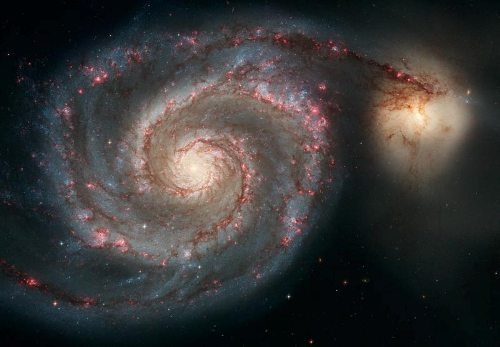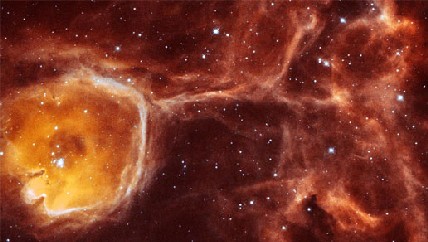The Monday Photo Shoot: Show off your favorite Hubble Space Telescope image. Tell us why you love it.
First off, a recently-featured one. Probably everyone will use it, but I like it so much that I'll post it anyway:
Out of This Whirl: the Whirlpool Galaxy (M51) and Companion Galaxy
 "The graceful, winding arms of the majestic spiral galaxy M51 (NGC 5194) appear like a grand spiral staircase sweeping through space. They are actually long lanes of stars and gas laced with dust.
"The graceful, winding arms of the majestic spiral galaxy M51 (NGC 5194) appear like a grand spiral staircase sweeping through space. They are actually long lanes of stars and gas laced with dust.
This sharpest-ever image of the Whirlpool Galaxy, taken in January 2005 with the Advanced Camera for Surveys aboard NASA's Hubble Space Telescope, illustrates a spiral galaxy's grand design, from its curving spiral arms, where young stars reside, to its yellowish central core, a home of older stars. The galaxy is nicknamed the Whirlpool because of its swirling structure."
I like that it's shiny and delicate and violet. It looks like fairy dust, or a giant space amoeba (or, more likely, a galaxy) reproducing itself with a light-filled touch.

Here's another one I couldn't bear to leave out, the Cat's Eye Nebula. Are you sure this wasn't done with CGI?
Dying Star Creates Fantasy-like Sculpture of Gas and Dust
The rest of these are older. I posted this photo last year as part of the AOL-J Anniversary "Starlight Cyberball."
A Celestial Geode
www.nasa.gov 
From NASA description: "In this unusual image, NASA's Hubble Space Telescope captures a rare view of the celestial equivalent of a geode -- a gas cavity carved by the stellar wind and intense ultraviolet radiation from a hot young star."
Why do I like this? It could be anything--any of a number of phenomena that I don't understand but would like to know about. Most of all, it reminds me of "The Doomsday Machine," the late Dan Cheney's favorite Star Trek episode.
And:
Hubble Identifies Source of Ultraviolet Light in an Old Galaxy

"As announced on October 26, 1999, NASA Hubble Space Telescope's exquisite resolution has allowed astronomers to resolve, for the first time, hot blue stars deep inside the small nearby elliptical galaxy M32. Images were obtained with the Space Telescope Imageing Spectrograph (STIS) of a small portion near the center of M32, about 1/20th the diameter of the galaxy. With this observation, Hubble discovered that the ultraviolet light comes from a population of extremely hot helium-burning stars. About 8000 of these late-stage stars were found near the core of the neighboring galaxy, "resembling a blizzard of snowflakes", as the Nasa release puts it."
I like this one because, well, it's so pretty! It's cheerful and inspirational.
And finally, a before and after:
Quintuplet Cluster 
(Hubble Space Telescope image PR99-30B 9/16/99)
"Penetrating 25,000 light-years of obscuring dust and myriad stars, NASA's Hubble Space Telescope has provided the clearest view yet of one of the largest young clusters of stars insideour Milky Way galaxy, located less than 100 light-years from the very center of the Galaxy."
This last one is superficially just a star field, but the colors and clusters of brightness make it especially pretty, almost magical.
When I posted this last year, I made it a background for something silly:

By the way, Hubble is in danger of being abandoned by NASA. Save the Hubble!
Karen

 You are looking at an archive edition of
You are looking at an archive edition of 



2 comments:
great pictures! http://journals.aol.com/pixiedustnme/Inmyopinion/entries/937
Wow! Synchronicity! The 1st image is presently my background! Got it from my son.
V
Post a Comment